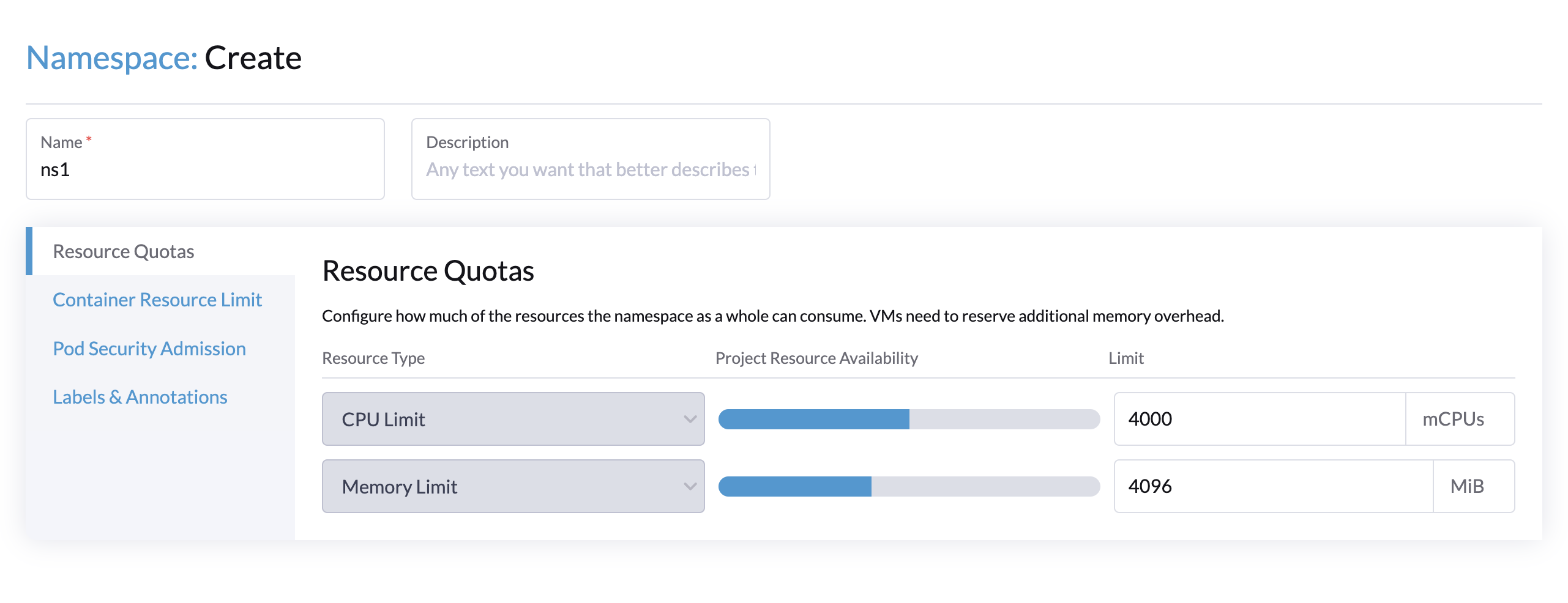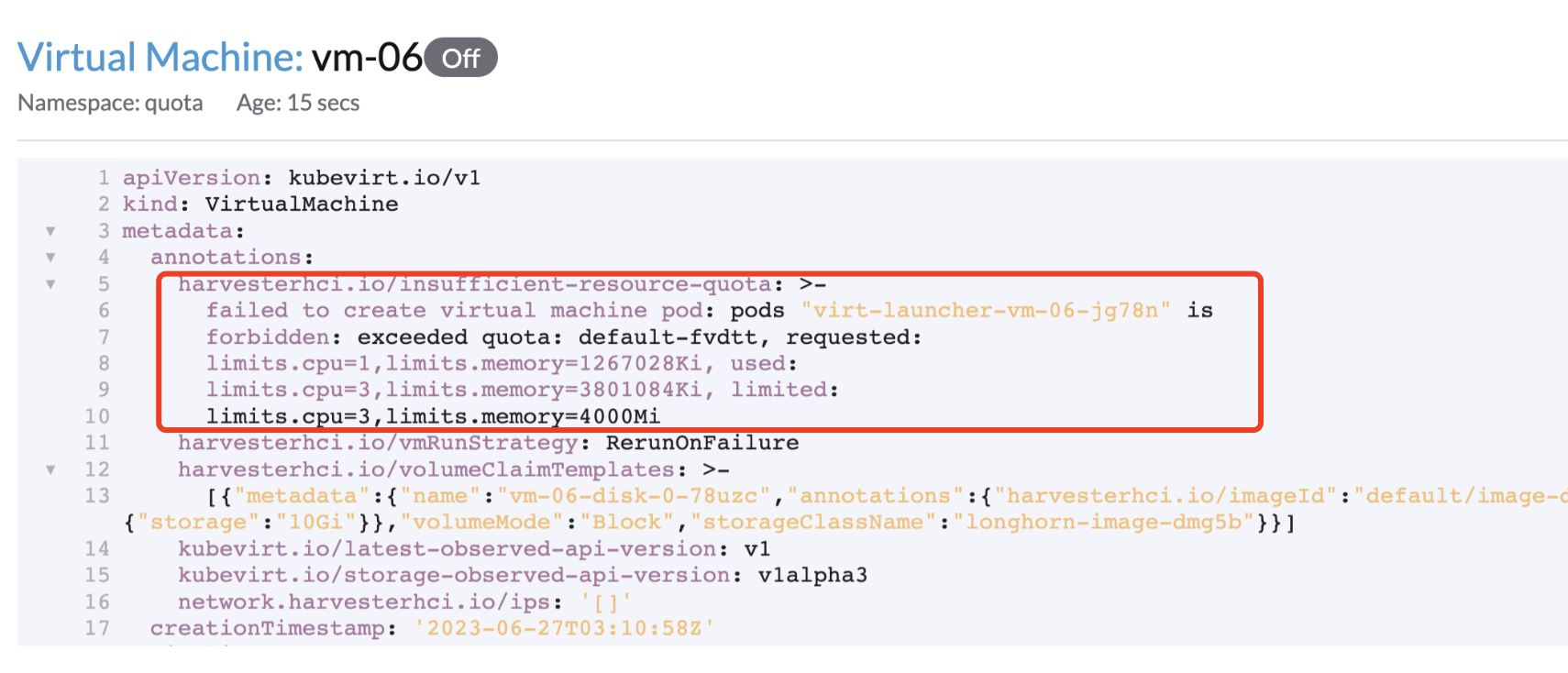Resource Quotas
ResourceQuota is used to limit the usage of resources within a namespace. It helps administrators control and restrict the allocation of cluster resources to ensure fairness and controlled resource distribution among namespaces.
In SUSE Virtualization, ResourceQuota can define usage limits for the following resources:
-
CPU: Limits compute resource usage, including CPU cores and CPU time.
-
Memory: Limits the usage of memory resources in bytes or other recognizable memory units.
Set ResourceQuota via Rancher
Administrators can configure resource quotas for namespaces by performing the following steps:
-
On the Rancher UI, go to ≡ → Virtualization Management.
-
Select a cluster, go to Projects/Namespaces, and then click Create Project.
-
In the general information section, specify a name and description for the project.
-
On the Resource Quotas tab, click Add Resource, select a resource type, and specify the corresponding limit values.

-
Click Create.
|
The VM Default Resource Limit tab contains resource reservation and limit settings that are applied only to pod workloads running within the namespace. Values configured on this tab correspond to the |
You can configure the Namespace limits as follows:
-
Find the newly created project, and select Create Namespace.
-
Specify the desired namespace Name, and adjust the limits.
-
Complete the process by selecting Create.

|
Attempts to provision virtual machines for guest clusters are blocked when the resource quotas are reached. Rancher responds by creating a new virtual machine in a loop, in which each failed creation attempt is immediately followed by another attempt. This results in a transient error state in the cluster that is not recorded as the virtual machine is recreated. |
Overhead memory of virtual machine
Upon creating a virtual machine (VM), the VM controller seamlessly incorporates overhead resources into the VM’s configuration. These additional resources intend to guarantee the consistent and uninterrupted functioning of the VM. It’s important to note that configuring memory limits requires a higher memory reservation due to the inclusion of these overhead resources.
For example, consider the creation of a new VM with the following configuration:
-
CPU: 8 cores
-
Memory: 16Gi
|
The operating system, either Linux or Windows, does not affect overhead calculations. |
Memory Overhead is calculated in the following sections:
-
Memory PageTables Overhead: This accounts for one bit for every 512b RAM size. For instance, a memory of 16Gi requires an overhead of 32Mi.
-
VM Fixed Overhead: This consists of several components:
-
VirtLauncherMonitorOverhead: 25Mi (thepsRSS for virt-launcher-monitor) -
VirtLauncherOverhead: 75Mi (thepsRSS for the virt-launcher process) -
VirtlogdOverhead: 17Mi (thepsRSS for virtlogd) -
LibvirtdOverhead: 33Mi (thepsRSS for libvirtd) -
QemuOverhead: 30Mi (thepsRSS for qemu, minus the RAM of its (stressed) guest, minus the virtual page table)
-
-
8Mi per CPU (vCPU) Overhead: Additionally, 8Mi of overhead per vCPU is added, along with a fixed 8Mi overhead for IOThread.
-
Extra Added Overhead: This encompasses various factors like video RAM overhead and architecture overhead. Refer to Additional Overhead for further details.
This calculation demonstrates that the VM instance necessitates an additional memory overhead of approximately 276Mi.
For more information, see Memory Overhead.
For more information on how the memory overhead is calculated in Kubevirt, refer to kubevirt/pkg/virt-controller/services/template.go.
Automatic adjustment of ResourceQuota during migration
When the allocated resource quota controlled by the ResourceQuota object reaches its limit, migrating a VM becomes unfeasible. The migration process automatically creates a new pod mirroring the resource requirements of the source VM. If these pod creation prerequisites surpass the defined quota, the migration operation cannot proceed.
In SUSE Virtualization, the ResourceQuota values will dynamically expand ahead of migration to accommodate the resource needs of the target virtual machine. After migration, the ResourceQuotas will be reinstated to their prior configurations.
Please be aware of the following constrains of the automatic resizing of ResourceQuota:
-
ResourceQuotacannot be changed during VM migration. -
When raising the
ResourceQuotavalue, if you create, start, or restore other VMs, SUSE Virtualization will verify if the resources are sufficient based on the originalResourceQuota. If the conditions are not met, the system will alert that the migration process is not feasible. -
After expanding
ResourceQuota, potential resource contention may occur between non-VM pods and VM pods, leading to migration failures. Therefore, deploying custom container workloads and VMs to the same namespace is not recommended. -
Due to the concurrent limitation of the webhook validator, the VM controller will execute a secondary validation to confirm resource sufficiency. If the resource is insufficient, it will auto config the VM’s
RunStrategytoHalted, and a new annotationharvesterhci.io/insufficient-resource-quotawill be added to the VM object, informing you that the VM was shut down due to insufficient resources.